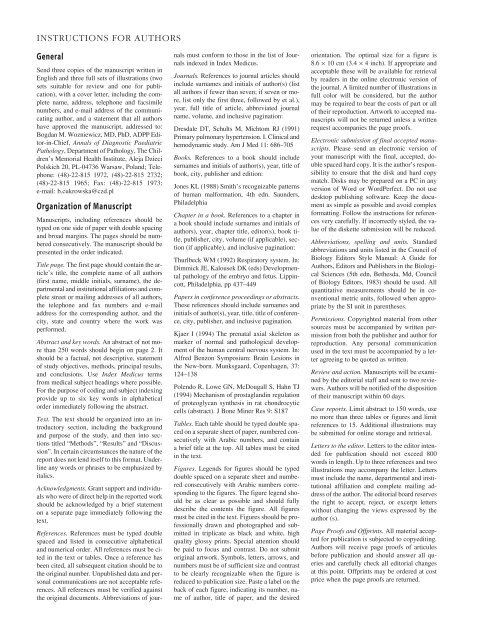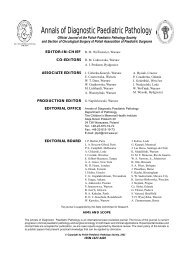annals 1-2.qxd - Centrum Zdrowia Dziecka
annals 1-2.qxd - Centrum Zdrowia Dziecka
annals 1-2.qxd - Centrum Zdrowia Dziecka
Create successful ePaper yourself
Turn your PDF publications into a flip-book with our unique Google optimized e-Paper software.
INSTRUCTIONS FOR AUTHORS<br />
General<br />
Send three copies of the manuscript written in<br />
English and three full sets of illustrations (two<br />
sets suitable for review and one for publication),<br />
with a cover letter, including the complete<br />
name, address, telephone and facsimile<br />
numbers, and e-mail address of the communicating<br />
author, and a statement that all authors<br />
have approved the manuscript, addressed to:<br />
Bogdan M. Wozniewicz, MD, PhD, ADPP Editor-in-Chief,<br />
Annals of Diagnostic Paediatric<br />
Pathology, Department of Pathology, The Children’s<br />
Memorial Health Institute, Aleja Dzieci<br />
Polskich 20, PL-04736 Warsaw, Poland; Telephone:<br />
(48)-22-815 1972, (48)-22-815 2732;<br />
(48)-22-815 1965; Fax: (48)-22-815 1973;<br />
e-mail: b.cukrowska@czd.pl<br />
Organization of Manuscript<br />
Manuscripts, including references should be<br />
typed on one side of paper with double spacing<br />
and broad margins. The pages should be numbered<br />
consecutively. The manuscript should be<br />
presented in the order indicated.<br />
Title page. The first page should contain the article’s<br />
title, the complete name of all authors<br />
(first name, middle initials, surname), the departmental<br />
and institutional affiliations and complete<br />
street or mailing addresses of all authors,<br />
the telephone and fax numbers and e-mail<br />
address for the corresponding author, and the<br />
city, state and country where the work was<br />
performed.<br />
Abstract and key words. An abstract of not more<br />
than 250 words should begin on page 2. It<br />
should be a factual, not descriptive, statement<br />
of study objectives, methods, principal results,<br />
and conclusions. Use Index Medicus terms<br />
from medical subject headings where possible.<br />
For the purpose of coding and subject indexing<br />
provide up to six key words in alphabetical<br />
order immediately following the abstract.<br />
Text. The text should be organized into an introductory<br />
section, including the background<br />
and purpose of the study, and then into sections<br />
titled “Methods”, “Results” and “Discussion”.<br />
In certain circumstances the nature of the<br />
report does not lend itself to this format. Underline<br />
any words or phrases to be emphasized by<br />
italics.<br />
Acknowledgments. Grant support and individuals<br />
who were of direct help in the reported work<br />
should be acknowledged by a brief statement<br />
on a separate page immediately following the<br />
text.<br />
References. References must be typed double<br />
spaced and listed in consecutive alphabetical<br />
and numerical order. All references must be cited<br />
in the text or tables. Once a reference has<br />
been cited, all subsequent citation should be to<br />
the original number. Unpublished data and personal<br />
communications are not acceptable references.<br />
All references must be verified against<br />
the original documents. Abbreviations of journals<br />
must conform to those in the list of Journals<br />
indexed in Index Medicus.<br />
Journals. References to journal articles should<br />
include surnames and initials of author(s) (list<br />
all authors if fewer than seven; if seven or more,<br />
list only the first three, followed by et al.),<br />
year, full title of article, abbreviated journal<br />
name, volume, and inclusive pagination:<br />
Dresdale DT, Schults M, Michtom RJ (1991)<br />
Primary pulmonary hypertension. I. Clinical and<br />
hemodynamic study. Am J Med 11: 686–705<br />
Books. References to a book should include<br />
surnames and initials of author(s), year, title of<br />
book, city, publisher and edition:<br />
Jones KL (1988) Smith’s recognizable patterns<br />
of human malformation, 4th edn. Saunders,<br />
Philadelphia<br />
Chapter in a book. References to a chapter in<br />
a book should include surnames and initials of<br />
authors), year, chapter title, editor(s), book title,<br />
publisher, city, volume (if applicable), section<br />
(if applicable), and inclusive pagination:<br />
Thurlbeck WM (1992) Respiratory system. In:<br />
Dimmick JE, Kalousek DK (eds) Developmental<br />
pathology of the embryo and fetus. Lippincott,<br />
Philadelphia, pp 437–449<br />
Papers in conference proceedings or abstracts.<br />
These references should include surnames and<br />
initials of author(s), year, title, title of conference,<br />
city, publisher, and inclusive pagination.<br />
Kjaer I (1994) The prenatal axial skeleton as<br />
marker of normal and pathological development<br />
of the human central nervous system. In:<br />
Alfred Benzon Symposium: Brain Lesions in<br />
the New-born. Munksgaard, Copenhagen, 37:<br />
124–138<br />
Polendo R, Lowe GN, McDougall S, Hahn TJ<br />
(1994) Mechanism of prostaglandin regulation<br />
of proteoglycan synthesis in rat chondrocytic<br />
cells (abstract). J Bone Miner Res 9: S187<br />
Tables. Each table should be typed double spaced<br />
on a separate sheet of paper, numbered consecutively<br />
with Arabic numbers, and contain<br />
a brief title at the top. All tables must be cited<br />
in the text.<br />
Figures. Legends for figures should be typed<br />
double spaced on a separate sheet and numbered<br />
consecutively with Arabic numbers corresponding<br />
to the figures. The figure legend should<br />
be as clear as possible and should fully<br />
describe the contents the figure. All figures<br />
must be cited in the text. Figures should be professionally<br />
drawn and photographed and submitted<br />
in triplicate as black and white, high<br />
quality glossy prints. Special attention should<br />
be paid to focus and contrast. Do not submit<br />
original artwork. Symbols, letters, arrows, and<br />
numbers must be of sufficient size and contrast<br />
to be clearly recognizable when the figure is<br />
reduced to publication size. Paste a label on the<br />
back of each figure, indicating its number, name<br />
of author, title of paper, and the desired<br />
orientation. The optimal size for a figure is<br />
8.6 × 10 cm (3.4 × 4 inch). If appropriate and<br />
acceptable these will be available for retrieval<br />
by readers in the online electronic version of<br />
the journal. A limited number of illustrations in<br />
full color will be considered, but the author<br />
may be required to bear the costs of part or all<br />
of their reproduction. Artwork to accepted manuscripts<br />
will not be returned unless a written<br />
request accompanies the page proofs.<br />
Electronic submission of final accepted manuscripts.<br />
Please send an electronic version of<br />
your manuscript with the final, accepted, double<br />
spaced hard copy. It is the author’s responsibility<br />
to ensure that the disk and hard copy<br />
match. Disks may be prepared on a PC in any<br />
version of Word or WordPerfect. Do not use<br />
desktop publishing software. Keep the document<br />
as simple as possible and avoid complex<br />
formatting. Follow the instructions for references<br />
very carefully. If incorrectly styled, the value<br />
of the diskette submission will be reduced.<br />
Abbreviations, spelling and units. Standard<br />
abbreviations and units listed in the Council of<br />
Biology Editors Style Manual: A Guide for<br />
Authors, Editors and Publishers in the Biological<br />
Sciences (5th edn, Bethesda, Md, Council<br />
of Biology Editors, 1983) should be used. All<br />
quantitative measurements should be in conventional<br />
metric units, followed when appropriate<br />
by the SI unit in parentheses.<br />
Permissions. Copyrighted material from other<br />
sources must be accompanied by written permission<br />
from both the publisher and author for<br />
reproduction. Any personal communication<br />
used in the text must be accompanied by a letter<br />
agreeing to be quoted as written.<br />
Review and action. Manuscripts will be examined<br />
by the editorial staff and sent to two reviewers.<br />
Authors will be notified of the disposition<br />
of their manuscript within 60 days.<br />
Case reports. Limit abstract to 150 words, use<br />
no more than three tables or figures and limit<br />
references to 15. Additional illustrations may<br />
be submitted for online storage and retrieval.<br />
Letters to the editor. Letters to the editor intended<br />
for publication should not exceed 800<br />
words in length. Up to three references and two<br />
illustrations may accompany the letter. Letters<br />
must include the name, departmental and institutional<br />
affiliation and complete mailing address<br />
of the author. The editorial board reserves<br />
the right to accept, reject, or excerpt letters<br />
without changing the views expressed by the<br />
author (s).<br />
Page Proofs and Offprints. All material accepted<br />
for publication is subjected to copyediting.<br />
Authors will receive page proofs of articules<br />
before publication and should answer all queries<br />
and carefully check all editorial changes<br />
at this point. Offprints may be ordered at cost<br />
price when the page proofs are returned.

















